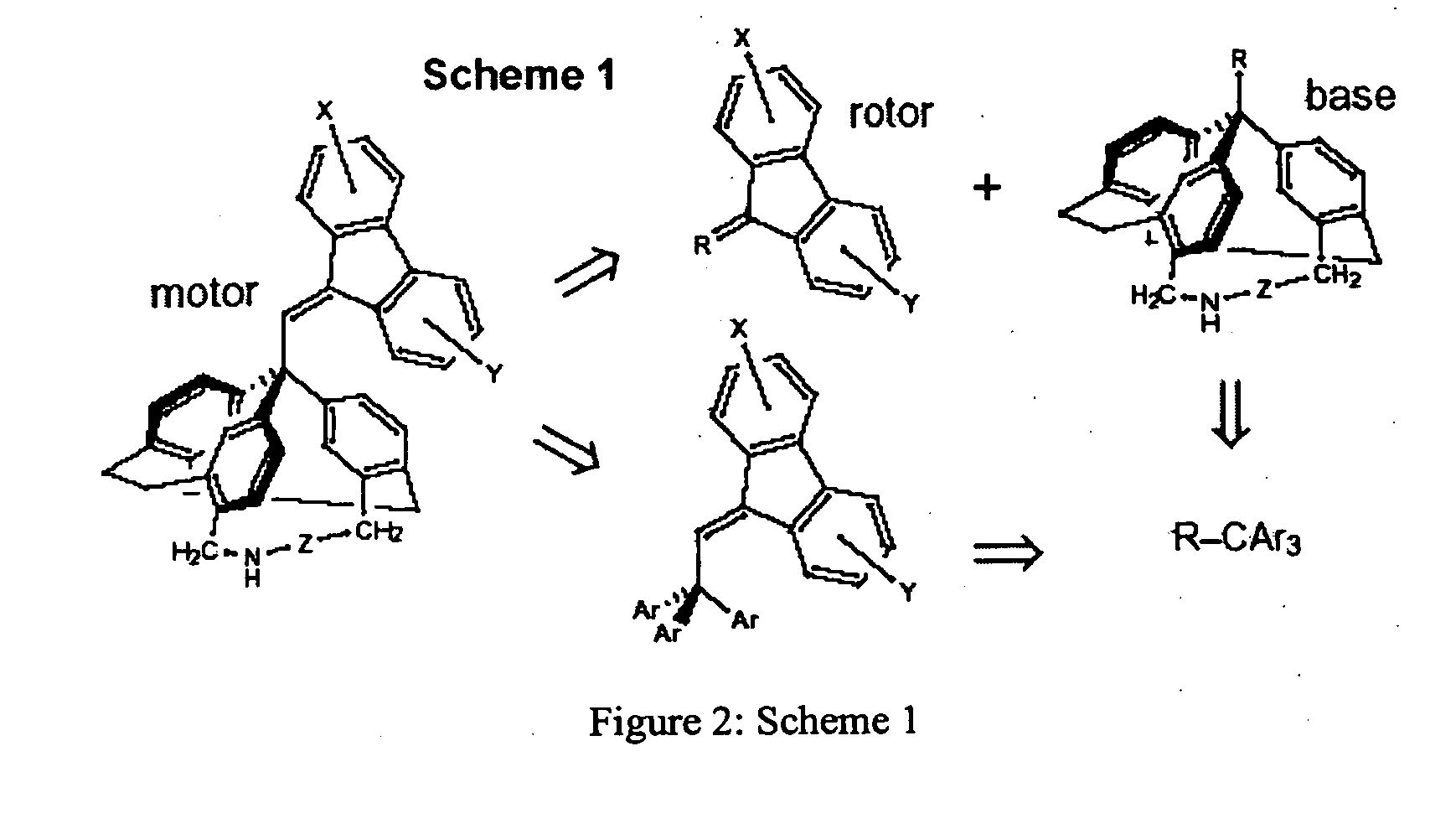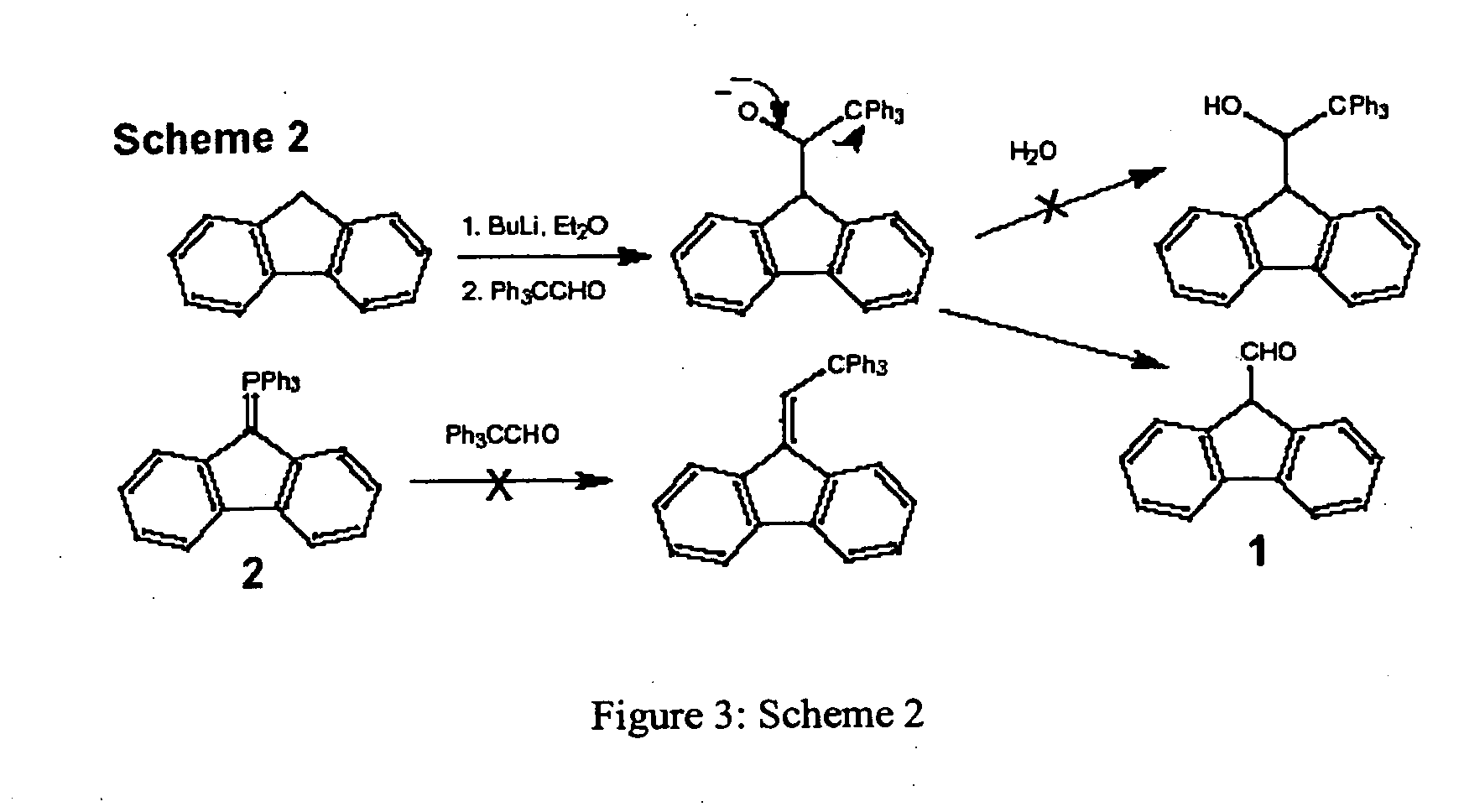Light-driven rotary molecular motors
a rotary molecular motor and light-driven technology, applied in the field of synthetic chemistry, photochemistry, advanced materials, nanometer-scale devices, etc., can solve the problems of complex and degradable fuel sources, limited utility of artificial nanostructure powering in many applications, and lack of precise temporal control of energizing/deenergizing the motor
- Summary
- Abstract
- Description
- Claims
- Application Information
AI Technical Summary
Problems solved by technology
Method used
Image
Examples
example 1
Synthesis of a Preferred Motor I
[0099]The stator in a preferred Motor I (see FIG. 1) consists of a triphenylmethane (trityl) group in which the three phenyl rings are linked together by three identical bridges (CH2NHZCH2). These bridges are attached to the phenyl rings in such a manner as to cause each ring to tilt. The resulting stator assembly adopts the shape of a three-bladed propeller. One end of the rotor is inserted into one of the grooves, or clefts, formed by two adjacent tilted phenyl blades.
[0100]The rotor and stator components of Motor I may bear additional substituents or be fused to additional rings so as to produce a stable molecular structure. Some modifications may be useful for the purpose of tuning the physical and chemical properties of the motor. For example, groups X and Y on the rotor may be polar (electron donating or withdrawing) substituents capable of altering the light absorption wavelength, excited state lifetime and twisting efficiency of the chromophor...
example 2
Synthesis of a Preferred Motor I and Fluorene Rotor Derivatives
[0112]A preferred compound having the structure of Motor I, (1) consists of an unsubstituted dibenzofulvene unit, and the base (stator) is a triphenylmethane in which the three-fold propeller shape is enforced by bridges containing a nitrogen atom and a C—C triple bond. FIG. 9 shows a retrosynthetic approach, which is based on the synthesis of 9-(2,2,2)-triphenylethylidenefluorene (2).1 A key disconnection corresponds to substitution of bromide in 9-bromomethylene-fluorene (3) with a triarylmethane anion derived from triamine 4. The amino groups may need to be protected as amide or silane derivatives during this substitution reaction and during the synthesis of intermediate 4. These amino groups provide anchor points for immobilizing the final motor on surfaces and incorporating it into DNA. The fluorene rotor will also need to be substituted in order to attach oligonucleotide strands and to tune the photophysical proper...
example 3
Synthesis of a Preferred Motor II
[0120]The molecular architecture of a preferred Motor II (FIG. 19) features a rigid C3-symmetric adamantane base. Three aryl (e.g., phenyl) or alkyl groups shown as R′ in the figure act as the three steric barriers or ridges restricting the rotation of the rotor about the torque angle. The size of this R′ group can be adjusted in order to tune the energy required for rotation of the rotor. The three R groups attached to the base can act as “feet” by anchoring it a surface or another molecule. For this purpose, they can be alkyl chains bearing terminal, reactive functional groups. Alternately, they can be used to adjust the polarity and solubility of the motor molecule. Motor II shares the same dibenzofulvene rotor structure with Motor I. In both cases, the rotor and various substituents can be varied, as described for Motor I.
[0121]Motor II is a desirable, complementary alternative to Motor I for the following reasons: (1) the C3-symmetric adamantane...
PUM
| Property | Measurement | Unit |
|---|---|---|
| Structure | aaaaa | aaaaa |
| Size | aaaaa | aaaaa |
| Flexibility | aaaaa | aaaaa |
Abstract
Description
Claims
Application Information
 Login to View More
Login to View More - R&D
- Intellectual Property
- Life Sciences
- Materials
- Tech Scout
- Unparalleled Data Quality
- Higher Quality Content
- 60% Fewer Hallucinations
Browse by: Latest US Patents, China's latest patents, Technical Efficacy Thesaurus, Application Domain, Technology Topic, Popular Technical Reports.
© 2025 PatSnap. All rights reserved.Legal|Privacy policy|Modern Slavery Act Transparency Statement|Sitemap|About US| Contact US: help@patsnap.com



